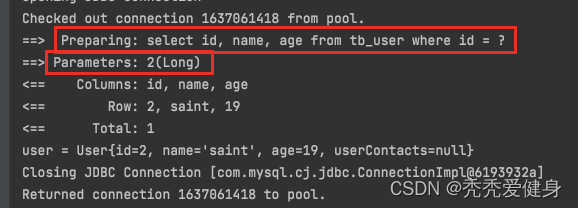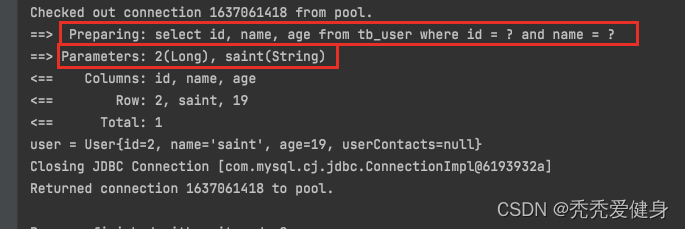一、Mybatis四种传递多个参数的方式
XML文件或者注解中都通过#{}获取参数的值,${}也可以,但是存在SQL注入问题。
1)参数索引
Mybatis会将参数放在map集合中,并以如下方式存储数据:
- 以param1, param2…为key,参数值为value。
多个参数可以使用类似于索引的方式传值,比如#{param1}对应第一个参数,#{param2}对应第二个参数…
1> Mapper方法:
User getUserByUserIdAndName(Long userId, String name);
2> XML文件内容:
<select id="getUserByUserIdAndName" resultType="com.saint.vo.User">
select
id, name, age
from
tb_user
where
id = #{param1} and name = #{param2}
</select>
根据开发规范,这种方式很不推荐!!
- 如果参数个数比较少,并且不想使用Map、POJO的方式,可以使用参数名 替代 索引。
<select id="getUserByUserIdAndName" resultType="com.saint.vo.User">
select
id, name, age
from
tb_user
where
id = #{userId} and name = #{name}
</select>
控制台日志输出:

2)@Param
Mybatis会将参数放在map集合中,除了以param1, param2..为key的方式存储数据外,还会以如下方式存储数据:
- 以
@Param注解的value属性值为key,参数值为value。
1> Mapper方法:
User getUserById(@Param("id") Long id);
2> XML文件内容:
<select id="getUserById" parameterType="long" resultType="com.saint.vo.User">
select
id, name, age
from
tb_user
where
id = #{id}
</select>
控制台日志输出:

3)Map集合
Mybatis底层就是将入参转换成Map,入参直接传Map时,#{key}中的key就是Map中的key;
1> Mapper方法:
Message getMessageByMap(Map<String, Object> params);
2> XML文件内容:
<select id="getMessageByMap" parameterType="map" resultType="com.saint.vo.Message">
select
id, msg_id, status, content, deleted, create_time, update_time
from
tb_message
where
id = #{id} and msg_id = #{msgId}
</select>
3> Mapper方法的调用:
Map<String, Object> params = new HashMap<>();
params.put("userId", 2L);
params.put("userName", "saint");
User user = userMapper.getUserByMap(params);
控制台日志输出:

4)POJO实体类
多个参数也可以用实体类封装起来,此时对应的key就是属性名称,注意POJO实体类中的字段一定要有get方法。
1> Mapper方法:
List<User> getUserByUser(User user);
2> XML文件内容:
<select id="getUserByUser" parameterType="com.saint.vo.User" resultType="com.saint.vo.User">
select id, name, age
from tb_user
where 1=1
<if test="id != null">
and id = #{id}
</if>
<if test="name != null and name != ''">
and name = #{name}
</if>
<if test="age != null">
and age = #{age}
</if>
</select>
3> Mapper方法的调用:
User userParam = new User();
userParam.setName("saint");
userParam.setId(2L);
List<User> user = userMapper.getUserByUser(userParam);
System.out.println("user = " + user);
控制台日志输出:

二、后续
下一篇文章将针对这四种传参方式,从源码层面看一看MyBatis是如何处理的。